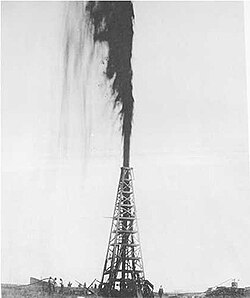Oil gusher: Difference between revisions
Father Goose (talk | contribs) can't believe this wasn't created yet; gonna nominate it for WP:DYK |
(No difference)
|
Revision as of 03:46, 3 August 2006

An oil gusher (or just gusher) is an uncapped oil well connected to a reservoir of petroleum oil under high pressure. The oil can shoot 200 feet (60 meters) or higher into the air. [1]
History
Gushers were an icon of oil exploration and production during the late 19th and early 20th Centuries. Drilling techniques and equipment employed at that time could not accomodate high-pressure reservoirs, and when the reservoirs were breached, the oil would shoot up the well, forcing out the drill head and creating a gusher. This event was referred to as a "blow out".
It was not until 1924 that the first successful blowout preventer, a valve affixed to the well head to regulate high-pressure oil flow, was brought to market.[2] Blowout preventers soon became standard equipment, and gushers became largely a thing of the past.
Gushers were dangerous and wasteful. They could kill workmen involved in drilling, destroy equipment, and coat the landscape with thousands of barrels of oil. The freely-flowing oil was in constant danger of catching fire.[3] One dramatic account of a blow out reads, "With a roar like a hundred express trains racing across the countryside, the well blew out, spewing oil in all directions. The derrick simply evaporated. Casings wilted like lettuce out of water, as heavy machinery writhed and twisted into grotesque shapes in the blazing inferno."[4]
Notable gushers
The Lakeview Gusher in Kern County, California of 1910 is believed to be the largest-ever U.S. gusher. At its peak, more than 100,000 barrels of oil per day flowed out. It remained uncapped for 18 months, spilling over nine million barrels (378 million gallons/1.4 billion liters) of oil, less than half of which was recovered.[5]
The Lucas Gusher at Spindletop in Beaumont, Texas in 1901 spewed out 100,000 barrels of oil per day at its peak, but soon slowed and was capped within nine days. The well tripled U.S. oil production overnight and marked the start of the Texas oil industry.[[6]]
The Wild Mary Sudik gusher in Oklahoma City in 1930 flowed at a rate of 72,000 barrels per day. [7]
External links
San Joaquin Geological Society article on famous Californian gushers
